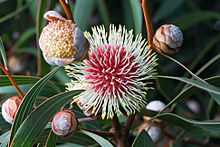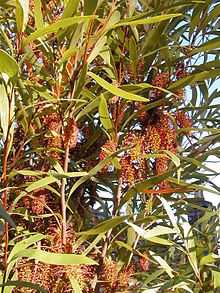Hakea is a genus of 149 species of shrubs and small trees in the Proteaceae, native to Australia. They are found throughout the country, with the highest species diversity being found in the south west of Western Australia.
They can reach 1–6 m in height, and have spirally arranged leaves 2–20 cm long, simple or compound, sometimes (e.g. H. suaveolens) with the leaflets thin cylindrical and rush-like. The flowers are produced in dense flowerheads of variable shape, globose to cylindrical, 3–10 cm long, with numerous small red, yellow, pink, purple, pale blue or white flowers.
Hakeas are named after Baron Christian Ludwig von Hake, the 18th century German patron of botany, following Heinrich Schrader's description of Hakea teretifolia in 1797.[1]
It is now beginning to become accepted [2] that Grevillea is paraphyletic with respect to Hakea. It is likely, therefore, that Hakea may soon be transferred into Grevillea.
Classification
Hakeas are closely related to the genus Grevillea and Finschia, both members of the subfamily Grevilleoideae within the family Proteaceae. Many species have similar inflorescences, but hakeas can be distinguished by their woody seed pods.
Horticulture
Hakeas are popular ornamental plants in gardens in Australia, and in many locations are as common as grevilleas and banksias. Several hybrids and cultivars have been developed. They are best grown in beds of light soil which is watered but still well drained.
Some showy western species, such as Hakea multilineata, H. francisiana and H. bucculenta, require grafting onto hardy stock such as Hakea salicifolia for growing in more humid climates, as they are sensitive to dieback.
Many species, particularly (but not always) Eastern Australian species, are notable for their hardiness, to the point they have become weedy. Hakea gibbosa, H. sericea and H. drupacea (previously H. suaveolens) have been weeds in South Africa, Hakea laurina has become naturalized around Adelaide, and Hakea salicifolia, Hakea gibbosa and Hakea sericea are invasive weeds in New Zealand.

Hakea epiglottis

Hakea decurrens ssp. physocarpa
Species
- Hakea actites (Mulloway Needlebush, Wallum Hakea)
- Hakea aculeata (Column Hakea)
- Hakea acuminata
- Hakea adnata
- Hakea aenigma
- Hakea ambigua
- Hakea amplexicaulis (Prickly Hakea)
- Hakea anadenia
- Hakea arborescens (Yellow Hakea, Arrarruwurra (Groote Eylandt), Derinding (Kununurra))
- Hakea archaeoides
- Hakea asperma
- Hakea auriculata
- Hakea bakeriana
- Hakea baxteri (Fan Hakea)
- Hakea bicornata
- Hakea brachyptera (Short-winged Hakea)
- Hakea brownii (Fan-leaf Hakea)
- Hakea bucculenta (Red Pokers)
- Hakea candolleana
- Hakea carinata
- Hakea ceratophylla (Horned-leaf Hakea, Staghorn Hakea)
- Hakea chordophylla (Bootlace Oak, Bull Oak, Corkwood)
- Hakea chromatropa[3]
- Hakea cinerea (Ashy Hakea, Grey Hakea)
- Hakea circumalata
- Hakea clavata (Coastal Hakea)
- Hakea collina
- Hakea commutata
- Hakea conchifolia (Shell-leaved Hakea)
- Hakea constablei
- Hakea corymbosa (Cauliflower Hakea)
- Hakea costata (Ribbed Hakea)
- Hakea crassifolia
- Hakea cristata
- Hakea cucullata (Cup Hakea, Hooded Hakea, Scallops Hakea)
- Hakea cyclocarpa (Curved Fruit Hakea. Ram's Horn, Wild Bean)
- Hakea cycloptera (Elm-seed Hakea)
- Hakea cygna (Swan-fruit Hakea)
- Hakea dactyloides (Broad-leaved Hakea)
- Hakea denticulata (Stinking Roger)
- Hakea decurrens
- Hakea divaricata (Corkbark, Needlewood)
- Hakea dohertyi
- Hakea drupacea (previously H. suaveolens- Sweet-scented Hakea)
- Hakea elliptica (Oval-leaf Halea)
- Hakea edneiana (Flinders Range Hakea, Yantana, Yandena)
- Hakea eneabba
- Hakea epiglottis
- Hakea erecta
- Hakea eriantha (Tree Hakea)
- Hakea erinacea (Hedgehog Hakea)
- Hakea eyreana (Straggly Corkbark, Fork-leaved Ironwood)
- Hakea falcata (Sickle Hakea)
- Hakea ferruginea
- Hakea flabellifolia (Wedge Hakea)
- Hakea florida (Summer Snow)
- Hakea florulenta
- Hakea francisiana (Bottlebrush Hakea, Emu Tree, Grass Leaf Hakea, Narakulja)
- Hakea fraseri (Gorge Hakea)
- Hakea gibbosa (Hairy Hakea, Rock Hakea)
- Hakea gilbertii (Gilbert's Hakea)
- Hakea grammatophylla
- Hakea hastata
- Hakea hookeriana (Barren Range Hakea)
- Hakea horrida
- Hakea ilicifolia (Holly-leaved Hakea)
- Hakea incrassata (Marble Hakea)
- Hakea invaginata
- Hakea ivoryi (Ivory's Hakea, Corkbark Corkwood)
- Hakea kippistiana
- Hakea laevipes
- Hakea lasiantha (Woolly-flowered Hakea)
- Hakea lasianthoides
- Hakea lasiocarpha (Long-styled Hakea)
- Hakea laurina (Kodjet, Pincushion Hakea)
- Hakea lehmanniana (Blue Hakea)
- Hakea leucoptera (Needlewood Hakea, Pin Bush, Water Tree, Ilpeye (Arrernte))
- Hakea linearis
|
- Hakea lissocarpha (Honeybush Hakea)
- Hakea lissosperma (Mountain Needlewood)
- Hakea longiflora
- Hakea loranthifolia
- Hakea lorea (Corkwood, Witinti)
- Hakea maconochieana
- Hakea macraeana (Willow Needlewood)
- Hakea macrocarpa (Dogwood Hakea)
- Hakea macrorhyncha
- Hakea marginata
- Hakea megadenia
- Hakea megalosperma (Lesueur Hakea)
- Hakea meisneriana
- Hakea microcarpa (Small fruit Hakea, Adam's Needle)
- Hakea minyma
- Hakea mitchellii
- Hakea muelleriana (Desert Hakea)
- Hakea multilineata (Grass-leaved Hakea)
- Hakea myrtoides (Myrtle Hakea)
- Hakea neurophylla (Pink-flowered Hakea)
- Hakea newbeyana
- Hakea nitida (Frog Hakea, Shining Hakea, Tjiridi)
- Hakea nodosa (Yellow Hakea)
- Hakea obliqua (Needles & Corks)
- Hakea obtusa
- Hakea ochroptera
- Hakea oleifolia (Dungyn, Olive-leaf Hakea)
- Hakea orthorrhyncha (Bird Beak Hakea)
- Hakea pachyphylla
- Hakea pandanicarpa (Thick-leaved Hakea. Screw-Pine Hakea)
- Hakea pedunculata
- Hakea pendens
- Hakea persiehana
- Hakea petiolaris (Sea-urchin Hakea)
- Hakea platysperma (Cricket Ball Hakea, Talking Women, Woody Peach)
- Hakea plurinervia
- Hakea polyanthema
- Hakea preissii (Christmas Hakea, Needle Bush, Needle Tree)
- Hakea pritzelii
- Hakea propinqua
- Hakea prostrata (Harsh Hakea)
- Hakea psilorrhyncha (Needles and Corks)
- Hakea pulvinifera
- Hakea purpurea
- Hakea pycnoneura
- Hakea recurva (Djanokmurd, Standback)
- Hakea repullulans
- Hakea rhombales (Walukara)
- Hakea rigida
- Hakea rostrata (Beaked Hakea, Turkey Gobblers, Kidney Bush)
- Hakea rugosa (Dwarf hakea, Wrinkled Hakea)
- Hakea ruscifolia (Candle-spike Hakea)
- Hakea salicifolia (Willow-leaved Hakea)
- Hakea scoparia
- Hakea sericea (Needlebush)
- Hakea smilacifolia
- Hakea spathulata
- Hakea standleyensis
- Hakea stenocarpa (Narrow-fruited Hakea)
- Hakea stenophylla
- Hakea strumosa
- Hakea subsulcata
- Hakea sulcata (Furrowed Hakes)
- Hakea teretifolia (Dagger Hakea)
- Hakea tephrosperma (Hooked Needlewood, Striped Hakea)
- Hakea trifurcata (Two-leaf Hakea)
- Hakea trineura
- Hakea tuberculata
- Hakea undulata (Wavy-leaved Hakea)
- Hakea ulicina
- Hakea varia (Variable-leaved Hakea)
- Hakea verrucosa
- Hakea victoria (Lantern Hakea, Royal Hakea)
- Hakea vittata
|
References
 |
Wikimedia Commons has media related to Hakea. |
- Barker WR, Barker RM, Haegi L (1999). "Hakea". In Wilson, Annette (ed.). Flora of Australia: Volume 17B: Proteaceae 3: Hakea to Dryandra. CSIRO Publishing / Australian Biological Resources Study. pp. 1–170. ISBN 0-643-06454-0.
- Holliday Ivan (2005). Hakeas:a field and garden guide. Reed New Holland. ISBN 1-877069-14-0.
- Young, JA (2006). Hakeas of Western Australia : a field and identification guide. ISBN 978-0-9585778-2-3.
Notes
- ↑ Von Hake (*1745-1818*) was a Hanoverian official, among others serving as President of the Royal British and Electoral Brunswick-Lunenburgian Privy Council for the Duchies of Bremen and Verden in the years of 1800–1810.
- ↑ Weston, P.H., and Barker, N.P. (2006). "A new suprageneric classification of the Proteaceae, with annotated checklist of genera". Telopea 11: 314–344.
- ↑ "Hakea chromatropa". FloraBase. Department of Environment and Conservation, Government of Western Australia.
-
Hakea corymbosa from southwest WA
-
Hakea petiolaris from southwest WA
-
Hakea bakeriana from NSW Central Coast
-
Hakea archaeoides, from NSW North Coast
-
Hakea seed pod, ACT, Aust.
-
Flower of Hakea laurina (Pincushion Hakea) in Bonbeach, Victoria, Australia
External links








